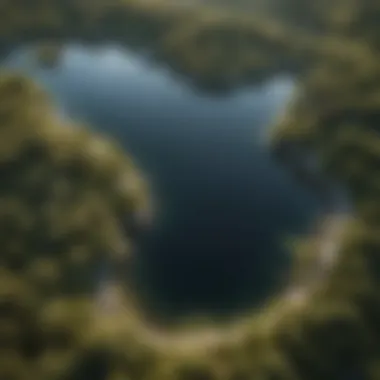Pond vs Lake: Key Differences and Ecological Insights


Intro
The ecosystems of ponds and lakes present fascinating study topics for students, researchers, and educators alike. Understanding their distinctions is crucial, as they play significant roles in biodiversity and environmental health. While both of these freshwater bodies may appear similar, they differ largely in size, depth, ecological dynamics, and human interactions.
Ponds are smaller and shallower than lakes. They typically allow sunlight to penetrate to the bottom, supporting a range of plant life. This feature encourages a different type of ecosystem compared to lakes, where deeper waters often inhibit light penetration. Lakes, on the other hand, can support more diverse aquatic life, including fish species that need deeper waters to thrive.
Moreover, the formation of each body of water involves complex geological and hydrological processes. This article will exhaustively analyze these distinctions, provide insights on their characteristics, and explore the broader ecological implications. Let's delve into the specifics.
Preamble to Aquatic Ecosystems
Aquatic ecosystems are integral to the functioning of our planet. These systems, mainly categorized into freshwater and marine environments, provide a myriad of benefits to both humans and wildlife. The distinctions between these ecosystems are not merely superficial. They encompass various characteristics that affect biodiversity, water quality, and the overall health of the environment. This article aims to elucidate these nuances through a detailed comparison of ponds and lakes, two prominent forms of freshwater bodies.
Overview of Freshwater Bodies
Freshwater bodies, such as ponds and lakes, cover a small percentage of the Earth's surface. However, their ecological significance is disproportionate to their size. These environments serve as critical habitats for a wide range of species, supporting complex food webs beyond the aquatic realm.
In its most basic form, a freshwater body is defined by its low salt concentration and the availability of water. The size and depth of these ecosystems are often used as criteria to classify them. For instance, lakes are generally larger and deeper than ponds, which can impact the types of flora and fauna that thrive within each.
The water movement is another defining feature. In contrast to lakes, which can exhibit a more stable hydrostatic environment, ponds may experience fluctuating water levels. This variability can lead to unique ecological dynamics.
Importance of Aquatic Ecosystems
The significance of aquatic ecosystems extends far beyond their physical presence. They play pivotal roles in nutrient cycling and water purification, which are essential for maintaining ecological balance.
- Biodiversity Support: Aquatic ecosystems are vital for nurturing diverse life forms, including plants, fish, amphibians, and insects. They provide critical breeding and feeding grounds, contributing to regional biodiversity.
- Carbon Sequestration: Bodies of freshwater can act as carbon sinks, trapping carbon dioxide within sediments, thus playing a role in mitigating climate change.
- Water Regulation: These ecosystems are crucial in regulating local hydrological cycles. They help maintain groundwater levels, reduce flooding, and protect watersheds.
- Cultural and Recreational Value: Ponds and lakes often serve as valuable recreational spaces for activities like fishing, swimming, and nature watching. They also hold cultural significance for many communities.
In summary, understanding aquatic ecosystems is essential for informed conservation efforts. Specifically, comparing ponds and lakes reveals critical insights into their diverse roles in the environment. Their differences may seem subtle, yet they hold profound implications for ecological studies and environmental management.
Defining Ponds
Defining ponds is crucial for understanding the broader context of freshwater ecosystems. These small bodies of water play significant roles in biodiversity, supporting various life forms. By examining the specific traits and functions of ponds, we can appreciate their relevance in both natural settings and human-made environments. Their characteristics help distinguish them from lakes, providing insights into their ecological importance and impacts on wildlife.
Characteristics of Ponds
Size criteria
One of the defining characteristics of ponds is their size. Typically, a pond is smaller than a lake, measuring less than 20 acres in surface area. This size difference influences the type of ecosystems that develop within these bodies of water. Because of their smaller scale, ponds often experience a more manageable level of nutrient input, which contributes to their clarity. However, the limited size can also pose challenges. For instance, smaller water bodies may dry up more quickly in drought conditions, affecting the organisms that depend on them.
Depth limitations


Ponds are usually shallow, generally not exceeding a depth of 6 to 10 feet. This shallow depth allows sunlight to penetrate more easily, promoting the growth of aquatic plants. These plants create a habitat for various species, directly influencing biodiversity. However, the reduced depth also means that ponds are more susceptible to temperature fluctuations, which can impact aquatic life. Maintaining a stable environment becomes more challenging compared to lakes, where deeper waters provide refuge from temperature extremes.
Water movement
Water movement in ponds is typically limited compared to more expansive bodies like lakes. Many ponds are stagnant or feature slow-moving water. The lack of significant water flow affects nutrient distribution and oxygen levels. While this can hinder certain species that thrive in flowing water, it also allows for the development of unique habitats where species adapted to still water can flourish. Thus, understanding water movement dynamics in ponds is essential in evaluating their ecological roles.
Ecological Role of Ponds
Biodiversity support
Ponds are vital for supporting biodiversity. Their unique conditions can host a wide range of organisms, from microscopic algae to amphibians and waterfowl. The diversity found in ponds often exceeds that of equivalent-sized lakes due to varied habitats created by vegetation, sediments, and microenvironments. However, habitat loss and pollution can threaten this delicate balance. It is critical to monitor and protect these ecosystems to maintain their biodiversity-rich communities.
Nutrient cycling
Nutrient cycling in ponds is intricate and supports a web of life. These ecosystems facilitate the breakdown and recycling of organic matter, allowing nutrients to re-enter the food web. Ponds also engage in processes like denitrification, which is essential for maintaining water quality. While nutrient contributions generally stem from natural processes, human activities can disrupt this cycle, leading to problems like eutrophication, which can diminish water quality.
Habitat for wildlife
Ponds serve as essential habitats for wildlife. They provide breeding grounds, food sources, and shelter for a multitude of species. Amphibians, many insect varieties, and birds find ponds particularly favorable for reproduction and feeding. This habitat role is crucial, especially in urban areas where natural habitats are becoming scarce. Efficient management of ponds can substantially benefit wildlife conservation efforts.
Pond Formation Processes
Natural processes
Ponds can form through various natural processes. They may result from glacial activity, old river channels, or the gradual accumulation of rainwater in depressions. Understanding these natural formation processes is important for assessing their ecological traits. Each formation method often leads to different nutrient levels and biological communities, affecting how the pond functions within its larger ecosystem.
Human intervention
Human intervention plays a significant role in pond formation as well. Agriculture and urban development often lead to the creation of artificial ponds. These ponds can serve various purposes, including irrigation, stormwater management, and aesthetic landscaping. However, human-made ponds may not always mimic the ecological balance of natural ponds. Their management requires careful planning to ensure they offer similar ecological benefits without negatively impacting surrounding ecosystems.
Defining Lakes
In understanding the distinctions between ponds and lakes, defining lakes is pivotal. Lakes serve as significant aquatic ecosystems that contribute to biodiversity and human interaction with natural water bodies. They are often larger and deeper compared to ponds, which alters their ecological functions and the services they provide.
Characteristics of Lakes
Size criteria
Lakes exhibit specific size criteria that distinguish them from ponds. Generally, a lake covers a larger area, often exceeding 2 hectares or 5 acres. This size impacts its ecological balance. Larger aquatic bodies tend to support more diverse and complex habitats. The extended area allows for varying zones, each with distinct biological communities. This feature underlines lakes' role in supporting a wider range of flora and fauna, making them essential for ecological studies.
Depth variations


Depth is another key characteristic of lakes. They can range significantly in depth, from shallow to very deep waters, sometimes exceeding hundreds of meters. The variable depth affects light penetration and thus influences the type of organisms that can thrive within them. Shallow areas often support rich plant life, while deeper regions may host specialized species adapted to low light conditions. This variability not only shapes the ecosystem but also affects how human activities impact water quality and habitat structure.
Thermal stratification
Thermal stratification is significant in lakes, especially during summer months. Lakes often form distinct thermal layers due to temperature differences in water at various depths. The upper layer, or epilimnion, tends to be warmer, while the bottom layer, known as the hypolimnion, remains cooler. This stratification influences oxygen levels and nutrient distribution. Understanding these thermal layers is crucial for ecological studies and for managing fish populations, as certain species depend on specific temperature ranges for spawning and survival.
Ecological Role of Lakes
Complex food webs
Lakes support complex food webs that are vital for ecosystem stability. Various organisms, from phytoplankton to larger fish species, interact within this intricate web. Each level in the food chain plays a role in maintaining ecological balance. These interactions can influence both water quality and habitat conditions. Understanding the food web structure helps in evaluating the health of a lake and its ecological resilience.
Water quality regulation
The role of lakes in regulating water quality cannot be underestimated. They act as natural filtration systems, trapping sediments and pollutants, which lessens their impact downstream. Lakes also provide a habitat for various organisms, such as filter feeders, which contribute to maintaining clean water conditions. Research into water quality regulation offers insights into addressing pollution and sustainable water management practices.
Recreation and human utility
Lakes serve multiple recreational and utilitarian purposes. They often provide spaces for activities such as fishing, boating, and swimming, benefiting local economies. Their aesthetic appeal also attracts tourism, which can support conservation efforts. However, human use can lead to over-exploitation and degradation, making it vital to implement sustainable practices. Understanding these dynamics helps in balancing human interests with ecological preservation.
Lake Formation Processes
Glacial activity
Glacial activity plays a crucial role in the formation of many lakes. As glaciers advance and retreat, they carve out depressions that fill with water. This process contributes to the creation of various lake types, including glacial lakes. The sheer size and depth of these lakes often lead to unique ecosystems. Such landscapes provide essential research opportunities into past climatic conditions and ecological succession.
Tectonic influences
Tectonic influences also contribute to lake formation. Many lakes emerge from tectonic activity, where shifts in the Earth's crust create depressions that hold water. These tectonic lakes can be found in regions with significant geological activity. Their unique formation process often results in distinct ecological characteristics. Understanding these influences is beneficial in studying regional geology and ecological diversity.
Volcanic origins
Some lakes originate from volcanic activity. Crater lakes, formed in volcanic calderas, exhibit specific features shaped by volcanic eruptions. These lakes often have unique chemical compositions, affecting local ecosystems. The study of volcanic lakes can provide insights into geological history and contemporary ecological processes. However, understanding their dynamics is essential for addressing potential hazards associated with volcanic activity.
Comparative Analysis
Comparative analysis between ponds and lakes is vital for understanding both their unique features and their roles within broader ecosystems. By systematically examining size, depth, biodiversity, and human influence, we can reveal insights that may otherwise remain obscured.
This section endeavors to clarify the contrasting characteristics of these freshwater bodies. Grasping these differences enhances our knowledge and helps in managing these ecosystems effectively. Moreover, such analysis allows us to appreciate the importance of conservation strategies tailored to each aquatic environment, offering solutions to mitigate human impact.
Size and Depth Differences


One of the most apparent distinctions between ponds and lakes is their size and depth. Ponds are generally smaller than lakes. Typically, a pond will cover an area of less than two acres. Additionally, ponds are often shallow, with a depth rarely exceeding twelve feet. Lakes, on the other hand, can span vast areas, extending across hundreds or even thousands of acres. Their depths also vary widely, with some lakes reaching depths that exceed thirty feet.
These size criteria shape the ecological dynamics present in each type of water body. For instance, the shallowness of ponds typically fosters a greater interaction between aquatic and terrestrial ecosystems. It allows for sunlight penetration, facilitating plant growth. In contrast, lakes with deeper zones might exhibit thermal stratification, isolating layers of water with different temperatures, which influences the types of organisms that can thrive within them.
Biodiversity and Habitat Disparities
Ponds and lakes also display significant differences in biodiversity. The habitat diversity in a pond can support a wide variety of organisms, including amphibians, insects, and various plant species. The shallower nature results in plant life proliferating, establishing a rich habitat for many organisms. This makes ponds important breeding grounds for many species.
Conversely, lakes, with their larger volumes of water, can host complex food webs. The diversity of species may be different, but the larger scale also supports larger populations. This creates a varied ecosystem that can include fish, large aquatic mammals, and diverse bird species that often depend on lakes for sustenance and breeding. Furthermore, lakes provide crucial resources for humans, influencing urban planning and water management strategies.
Human Impact on Ecosystems
Pollution levels
Pollution levels in ponds and lakes can vary considerably due to their distinct sizes and uses. Ponds, often situated close to agricultural areas, may suffer from runoff containing fertilizers and pesticides. This can lead to nutrient overload, promoting harmful algal blooms. Such changes directly affect the aquatic life and can diminish the pond's health. In addition, the smaller size of ponds makes them more vulnerable to contamination compared to lakes, as they have less dilution capacity.
In lakes, pollution sources can include industrial discharge, urban runoff, and organic waste. Their larger volume allows for some degree of dilution, but they can still experience significant ecological damage. Monitoring pollution levels in both settings is essential for maintaining ecological balance. Both ecosystems face challenges, yet understanding these effects is crucial in addressing the problems of water quality and ecosystem health.
Alteration of Natural Habitats
The alteration of natural habitats often leads to significant challenges for ponds and lakes. Urbanization, for example, frequently leads to the destruction of pond environments, diminishing their functions. Ponds are particularly affected due to their smaller size and location, making them prime targets for development projects.
Lakes, while also facing habitat alterations, often experience more extensive changes due to larger-scale projects, such as dam constructions or water diversion for irrigation. Altered water levels impact not just the lake ecosystem, but surrounding areas as well. These changes can decrease biodiversity and lead to the loss of endemic species. Assessing these alterations helps highlight the critical need for conservation efforts.
Conservation Efforts
Conservation efforts are essential for preserving both ponds and lakes. In ponds, initiatives may focus on restoring water quality and rebuilding native vegetation. Conservation in lakes often involves stricter regulation of water usage and pollution controls. The unique attributes of each ecosystem require tailored conservation strategies. This ensures that efforts address specific challenges they face while fostering sustainable use.
Understanding conservation measures also raises awareness among communities. Educating the public about the importance of ponds and lakes promotes responsible stewardship. Ultimately, effective conservation can restore ecological integrity, allowing both ponds and lakes to continue supporting diverse life forms.
"Understanding the distinctions between ponds and lakes is crucial for both ecological health and human interaction. Effective management depends on recognizing these differences."
In summary, the comparative analysis of ponds and lakes sheds light on their intricate ecosystem dynamics. Awareness of size, biodiversity, and human impacts enriches our understanding, making this analysis invaluable.
Finale
In this article, the importance of understanding the distinctions between ponds and lakes has been highlighted. Recognizing these differences supports better ecological management and conservation efforts. Each freshwater body plays a unique role in its ecosystem. For example, ponds often contribute significantly to local biodiversity and serve as nurseries for various aquatic species. On the other hand, lakes may have deeper waters and support complex food webs, impacting regional water quality and availability.
Summary of Key Points
- Characteristics: The article explored the defining features of ponds and lakes, focusing on aspects like size and depth. Ponds are typically smaller and shallower than lakes, and their water movement is often limited.
- Ecological Roles: Both ponds and lakes serve vital ecological functions. Ponds support diverse life forms and nutrient cycling, while lakes contribute to complex food webs and recreational opportunities.
- Human Impact: The influence of human activities, such as pollution and habitat alteration, affects both ponds and lakes. Understanding these impacts is crucial for developing effective conservation strategies.
Future Research Directions
Future studies should focus on several key areas:
- Longitudinal Studies: Examining the long-term changes in pond and lake ecosystems under changing climate conditions will provide valuable insights.
- Impact of Invasive Species: Investigating how invasive species affect biodiversity in both ponds and lakes can help develop better management practices.
- Water Quality Assessment: Analyses on how different human activities alter water quality across various freshwater bodies can assist in creating effective rehabilitation strategies.







